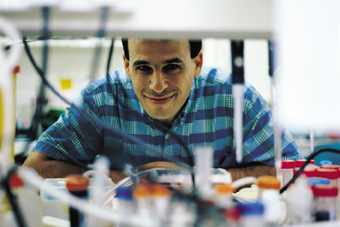The basic units of all living organisms can travel two main paths on their final journey. One is a form of self-sacrifice. Cell suicide, 'apoptosis,' occurs when cells have become potentially harmful or unnecessary. 'The kill is fast and tidy,' says Dr. Atan Gross of the Weizmann Institute's Biological Regulation Department. 'There are no leftovers, no inflammation, and no harm to surrounding cells.' The cell shrinks, dies, and is then eaten by other cells. Failure of this mechanism can lead to illnesses such as cancer, AIDS, or Alzheimer's disease.
But self-destruction doesn't come easy. A cell's self-destruction manual contains a complex set of instructions, which scientists have long struggled to decipher. In the 1980s, the discovery of a family of proteins called BCL-2, which plays a major role in apoptosis, transformed the field from an apparent impasse to one that might, with difficulty, be traversed. Research received a major boost when enzymes called caspases were found to also serve as activators of certain BCL-2 family members. The field was finally stimulated into what it is today - a focal point for cancer research, teeming with scientists who seek to solve this as yet undecipherable riddle.
Gross's team is conducting three separate studies related to apoptosis. Two deal with how the powerhouse of the cell, the mitochondrion, is involved in apoptosis. Scientists feel that understanding how the mitochondrion breaks apart in apoptosis is crucial to understanding cell suicide. Some believe that channels in the mitochondrion form during the process, and that the mitochondrion's innards leak through them. Other theories point to the formation of oxygen radicals as causing the rupture of the mitochondrion's membrane.
Most recently, Gross found that before apoptosis, a version of a molecule in the BCL-2 family, called tBID, forms aggregates in the mitochondrion's membrane, possibly in an effort to construct channels.
Hoping to explore this phenomenon further, Gross decided to check what happens when BAX, another molecule belonging to the BCL-2 family, is introduced into yeast. 'As a single-celled organism, yeast lacks its own apoptotic mechanism, thus offering an ideal control setting for selectively examining the effect of specific molecules on apoptosis,' explains Gross, adding that its single-celled status also makes it easy to manipulate.
An additional study, which Gross conducted in collaboration with Prof. Alex Tsafriri of the same department, deals with apoptosis in the ovary (atresia). Gross: 'Apoptosis is crucial to ovulation. Ovaries contain huge numbers of follicles, carrying immature eggs, of which thousands undergo atresia. Follicles that reach the ovulation stage are the exception to the rule.' Observing follicles in culture, he found that caspases were barely activated in apoptosis, and apoptosis still occurred when caspase activity was inhibited. On the other hand, when ovulation was induced, caspase activity, surprisingly, increased. Caspases, then, may play a non-apoptotic role in the ovulation process.
As Gross and other scientists work to unlock the secrets of apoptosis, one can only hope that new understandings in the field will lead to improved treatment of some of humankind's most menacing diseases.
Dr. Gross holds the Robert Armour Family Career Development Chair in Perpetuity. His research is supported by Mr. and Mrs. Stanley Chais, Beverly Hills, CA; the Dolfi and Lola Ebner Center for Biomedical Research; the Y. Leon Benoziyo Institute for Molecular Medicine; the Willner Family Center for Vascular Biology; Mr. and Mrs. Bram of Belgium; the Louis Chor Memorial Trust Fund; the Harry and Jeanette Weinberg Fund for Molecular Genetics of Cancer; Yad Hanadiv; the Jean-Jacques Brunschwig Fund for the Molecular Genetics of Cancer; and the Foundatin Fernande et Jean Gaj.
